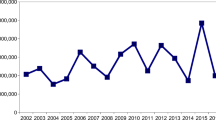Abstract
We classified forest resources into four modes: high timber output and high ecological reserve (Mode T-E); high timber output and low ecological reserve (Mode T-e); low timber output and low ecological reserve (Mode t-e); and low timber output and high ecological reserve (Mode t-E). Ecological reserve is stand volume per unit area of natural forests and total area of natural forests; timber output is defined as total area of timber forests and unit area of timber production. We used this classification system to examine forest development in China between 1950 and 2013. Data were acquired mainly from forest inventory statistics published by China’s Forestry Administration between the 1970s and 2013. I Information from the 1950s was acquired from relevant literature. Our analysis suggests that China’s forest resources transitioned from Mode t-E to Mode T-e during the period between the early 1950s and late 1970s, resulting in the destruction of both ecological vigor and timber resources. During the following 20 years, strategies were implemented to improve the ecological reserve and increase timber supply, resulting in a decline in the rate of forest degradation. Over the past decade, China’s forest resources have reached Mode T-E as a result of improvements in both the ecological reserve and the timber supply. Currently, the total area of timber forests is relatively low, representing the limiting factor for improvement in overall forest functionality. Nevertheless, along with increased efforts to protect natural forests and develop fast-growing forest plantations, it is hopeful that China’s forest resources will achieve a sustainable state. The four-mode TOER (timber output, ecological reserve) method introduced in this paper is a simple but an effective approach for characterizing the overall quality and quantity of forest resources. The data used for this type of evaluation are typically easy to obtain and reliable. This methodology has potential to be applied to forests in various regions and countries.




Similar content being viewed by others
References
China’s State Forestry Administration (SFA) (2014) Statistics of forest resources in China (2009–2013). China Forestry Publishing House, Beijing, p 483
Dai LM, Zhao W, Shao GF, Lewis BJ, Yu DP, Zhou L, Zhou WM (2013) The progress and challenges in sustainable forestry development in China. Int J Sustain Dev World Ecol 20(5):394–403
He FN, Ge QS, Dai JH, Lin SS (2007) Quantitative analysis on forest dynamics of China in recent 300 years. Acta Geogr Sin 62(1):30–40
Hu YH, He JJ (2012) Evolution of China’s forestry policy. J Beijing For Univ 11(3):21–27
Irland L (2010) Assessing sustainability for global forests: a proposed pathway to fill critical data gaps. Eur J For Res 129(5):777–786
Li WH, Li F, Liu MC (2006) The progress and prospective of forest ecological compensation. J Nat Resour 21(5):677–688
Niu X, Wang B, Liu SR, Liu CJ, Wei WJ, Kauppi PE (2012) Economical assessment of forest ecosystem services in China: characteristics and implications. Ecosyst Complex 11(1):1–11
Shen GF (2000) Sustainable development of forestry in China and its key scientific problems. Adv Earth Sci 15(1):10–18
Uhde B, Hahn WA, Griess VC, Knoke T (2015) Hybrid MCDA methods to integrate multiple ecosystem services in forest management planning: a critical review. Environ Manag 56(2):373–388
Wu G, Tan LB, Feng XC, Yu DP, Deng HB, Xu D (2015) Forest multi-target management planning of Lushuihe forestry bureau. Acta Ecol Sin 35(1):18–23
Zhang YX (2006) Change analysis on Chinese forest construction from year 1950 to 2003. J Beijing For Univ 28(6):80–87
Zhang YX (2008) Forest management conditions and problems from 1950 to 2003 in China. J Beijing For Univ 30(5):91–96
Zhang YQ (2013) Development of forestry knowledge and evaluation of forestry comprehensive benefits. Guid Sci Wealth. doi:10.3969/j.issn.1007-1547.2013.12.315
Zhang K (2014) Complete logging ban does not mean stopping any forest management. http://www.yicai.com/news/2014/04/3656215.html. Accessed 30 July 2016
Zhao JZ (2013) Theoretical considerations on ecological civilization development and assessment. Acta Ecol Sin 33(15):4552–4555
Zhou SX (2005) Forestry in China, historical transitions and industry developments. Cengage Learning, Singapore, p 416
Author information
Authors and Affiliations
Corresponding author
Additional information
Project funding: The work was supported by China's National Key Reaserch and Development Plan (2016YFC0502902).
The online version is available at http://www.springerlink.com
Corresponding editor: Tao Xu.
Rights and permissions
About this article
Cite this article
Bai, J., Zhao, Y., Shi, L. et al. Assessing forest sustainability trajectory with temporal changes in timber output and ecological reserve: the case of China. J. For. Res. 29, 171–176 (2018). https://doi.org/10.1007/s11676-017-0422-7
Received:
Accepted:
Published:
Issue Date:
DOI: https://doi.org/10.1007/s11676-017-0422-7




